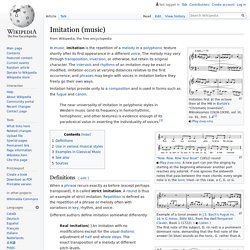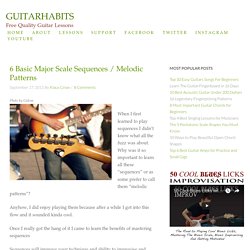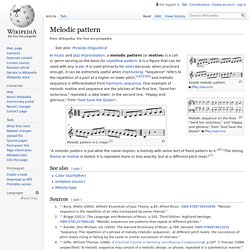

Scale Sequences: 15 Hot Patterns That Will Fire Up Your Solos. (Image: © Cindy Moorhead) If you’re a guitarist who loves to practice, you’re probably well acquainted with a scale sequence or two.

But if you think they’re best left for the practice room, think again. The fiery solos of hard rock are laced with 16th-note scale sequences—think Ritchie Blackmore, Randy Rhoads, Uli Jon Roth, Michael Schenker, John Petrucci, Paul Gilbert, Eric Johnson, Yngwie Malmsteen and Vinnie Moore. Jazz and fusion guitarists—including Django Reinhardt, Joe Pass, Joe Diorio, John Scofield and Frank Gambale—employ a wide variety of arpeggio and sequence-triad patterns.
Intervallic sequences also abound in the country stylings of Alert Lee, Brent Mason and Danny Gatton, and the blues idiom is peppered with triplet-based sequences. In this lesson, we’ll take look at the power of these patterns and explore ways you can put them to use to ignite your solos and licks with a new intensity. Moving Across the Fretboard in Unusual Ways to Produce Unique Runs. (Image: © Scott Legato/Getty Images) Over the years, people have noticed that when I play certain runs, my fingers move in the opposite direction of the notes that they hear.

For example, as my fret hand moves up the fretboard, the sequence of notes that is heard descends (and vice versa). For this column, I’ve put together a few runs that demonstrate this unusual approach as applied to both ascending and descending patterns. Pentatonic Sequencing In Groups Of Five Notes. Scale Sequences That Will Fire Up Your Solos-Pentatonic Sequencing In Groups Of Five Notes.
Imitation (music) Play .

"Row, Row, Row Your Boat" (1852) round Different authors define imitation somewhat differently: Imitation[:] The repetition of a melody or melodic group in close succession, but in a different voice; the repetition of a melody at a different pitch level in a polyphonic texture. homodirectional imitation...contradirectional...contrarhythmic imitation...contraintervallic imitation...free imitation...strict imitation...rhythmic imitation...contour imitation In European classical music, imitative writing was featured heavily in the highly polyphonic compositions of the Renaissance and Baroque eras.
Imitation featured in both instrumental and vocal music of the Renaissance. Andrea Gabrieli Ricercare del 12o tono Bach Fugue XXII in B flat minor BWV 868, opening Later, the theme is imitated through all five parts at the distance of just one beat: 6 Basic Major Scale Sequences / Melodic Patterns - GUITARHABITS. Photo by Gideon When I first learned to play sequences I didn’t know what all the fuzz was about.

Why was it so important to learn all these “sequences” or as some prefer to call them “melodic patterns”? Anyhow, I did enjoy playing them because after a while I got into this flow and it sounded kinda cool. Once I really got the hang of it I came to learn the benefits of mastering sequences Sequences will improve your technique and ability to improvise and create melody on the spot. Your playing becomes more flexible, creative and it’ll keep you from sounding like someone who is playing scales all the time. :-) In other words… Want to improve your technique or want to improve your improvising skills?
Go ahead and work hard on these assignments. Enjoy! Assignment #1: Memorize the G Major scale and play it using alternate picking. Assignment #2: Memorize the 6 sequences below (ascending and descending) and play them through the cycle of fourths. These assignments will keep you busy for a while. Guitarplayer. Melodic Sequences on Guitar - Fundamental Changes Music Book Publishing. Sequence (music) Two segments, usually no more than three or fourUsually in only one direction: continuingly higher or lowerSegments continue by same interval distance It is possible for melody or harmony to form a sequence without the other participating.

Sequence ascending by step Play . Note that there are only four segments, continuingly higher, and that the segments continue by similar distance (seconds: C-D, D-E, etc.). Real, rather than tonal, sequence. Play Melodic sequence on the lines "Send her victorious," and "Happy and glorious," from "God Save the Queen" Play There are many types of sequences, each with a unique pattern. Bach Concerto for Two Violins in D minor first movement bars 22-24. Melodic Patterns - 112 scale sequences for improving melodic freedom. Practicing melodic patterns (sometimes called sequences) is one of the best methods available for learning scale fingerings.

Their practice will also aid in learning the sounds of the various scales, as well as, help you to improvise lead lines from different scales. The concept is very simple, the variations endless. Melodic pattern. Simple melodic pattern.

Play Melodic sequence on the lines "Send her victorious," and "Happy and glorious," from "God Save the Queen" Play Melodic pattern in C major.[5] See also[edit] Sources[edit] ^ Berg, Shelly (2005). Further reading[edit] Hanon, C.L. (2000) The Virtuoso Pianist.